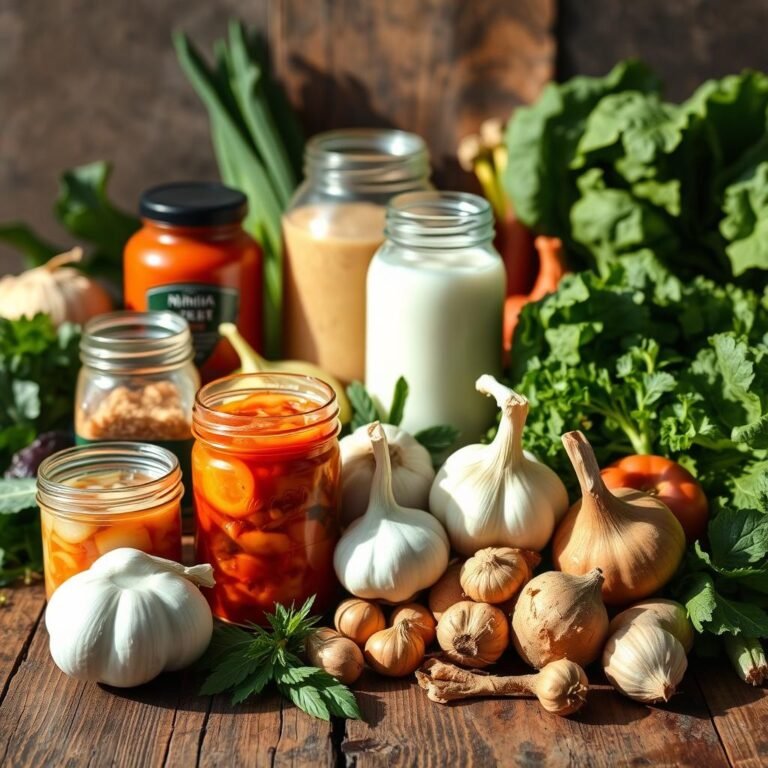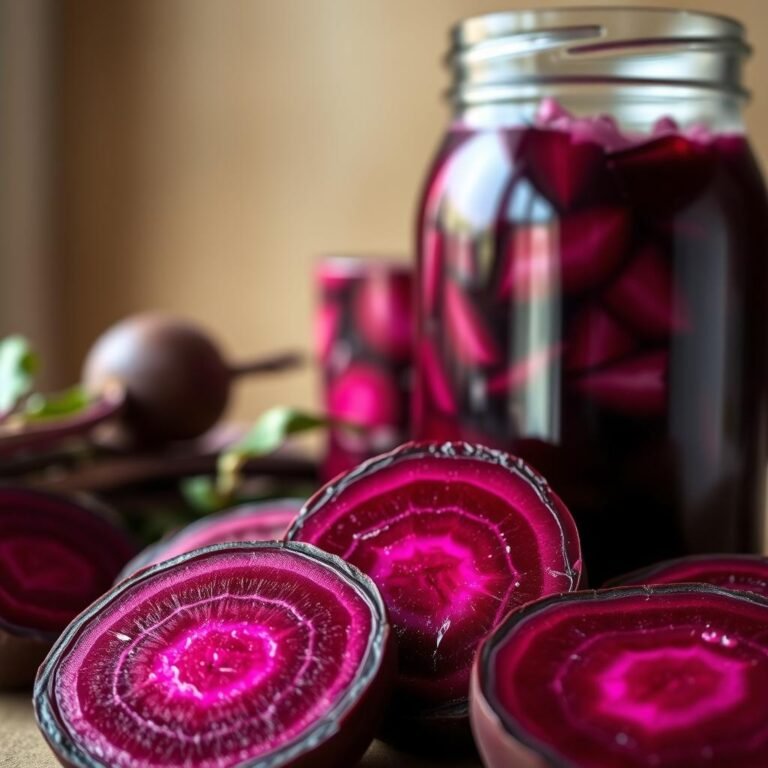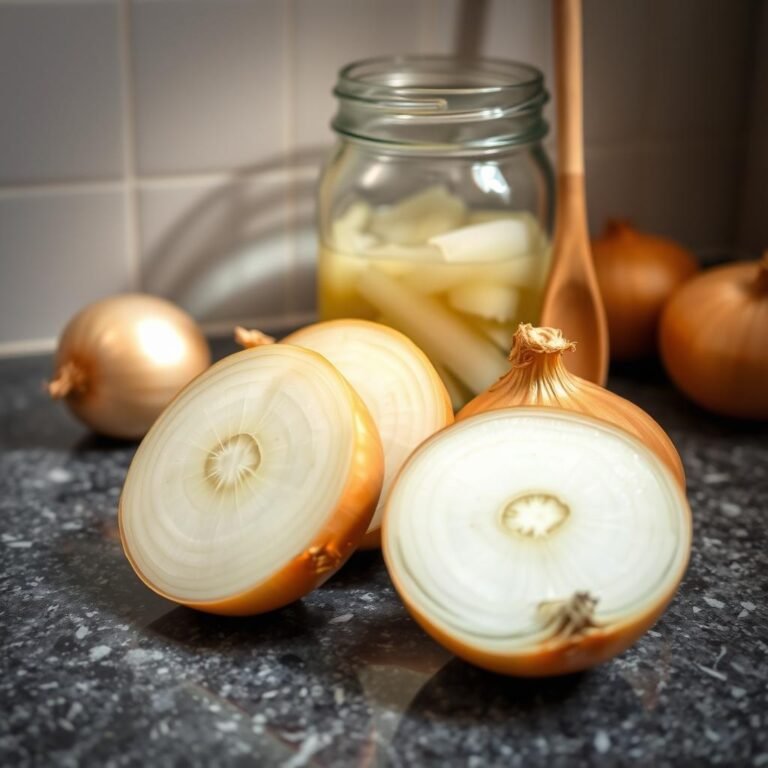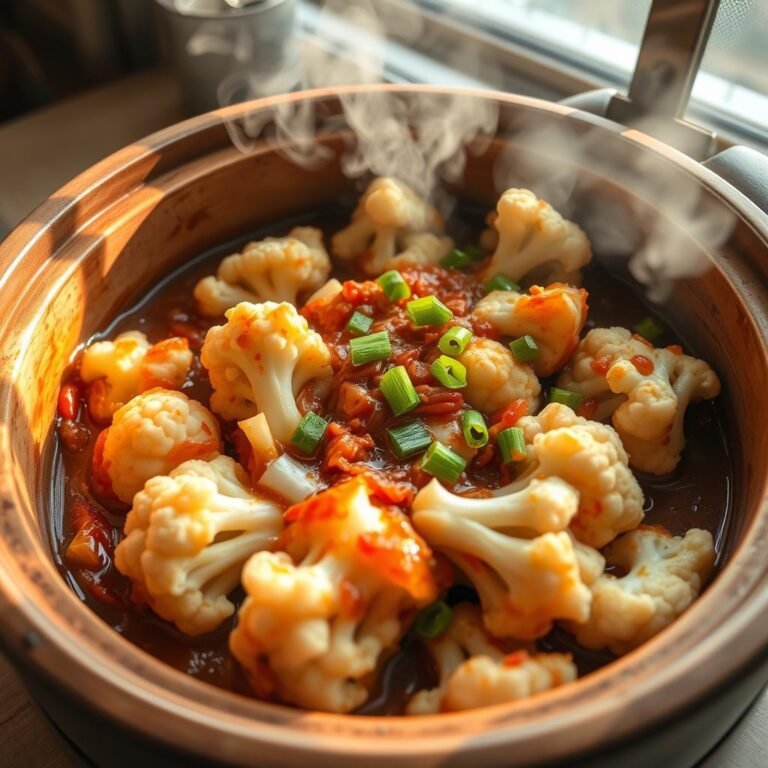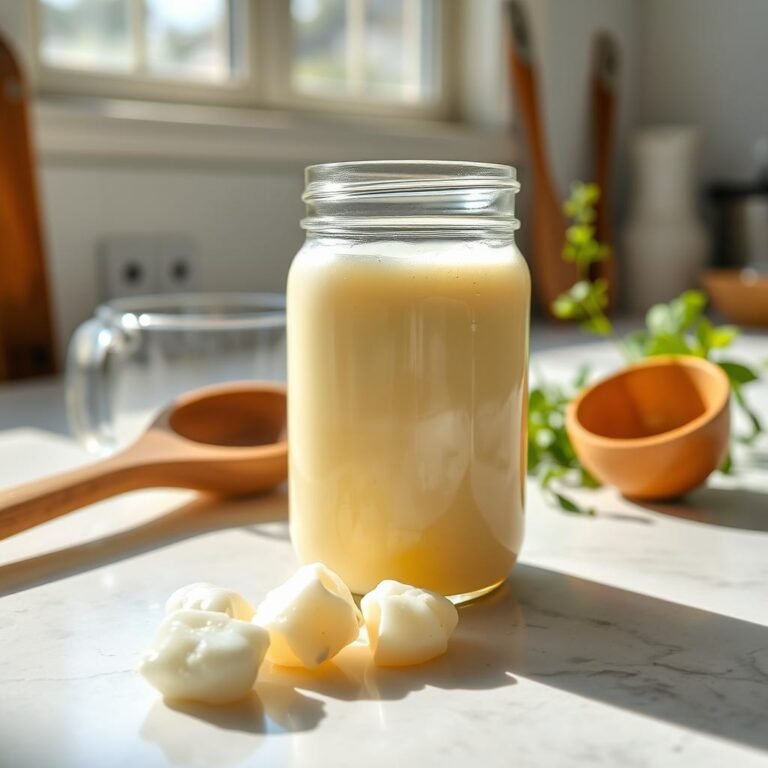Brined Dill Pickle Recipe with Fermentation for Better Immunity
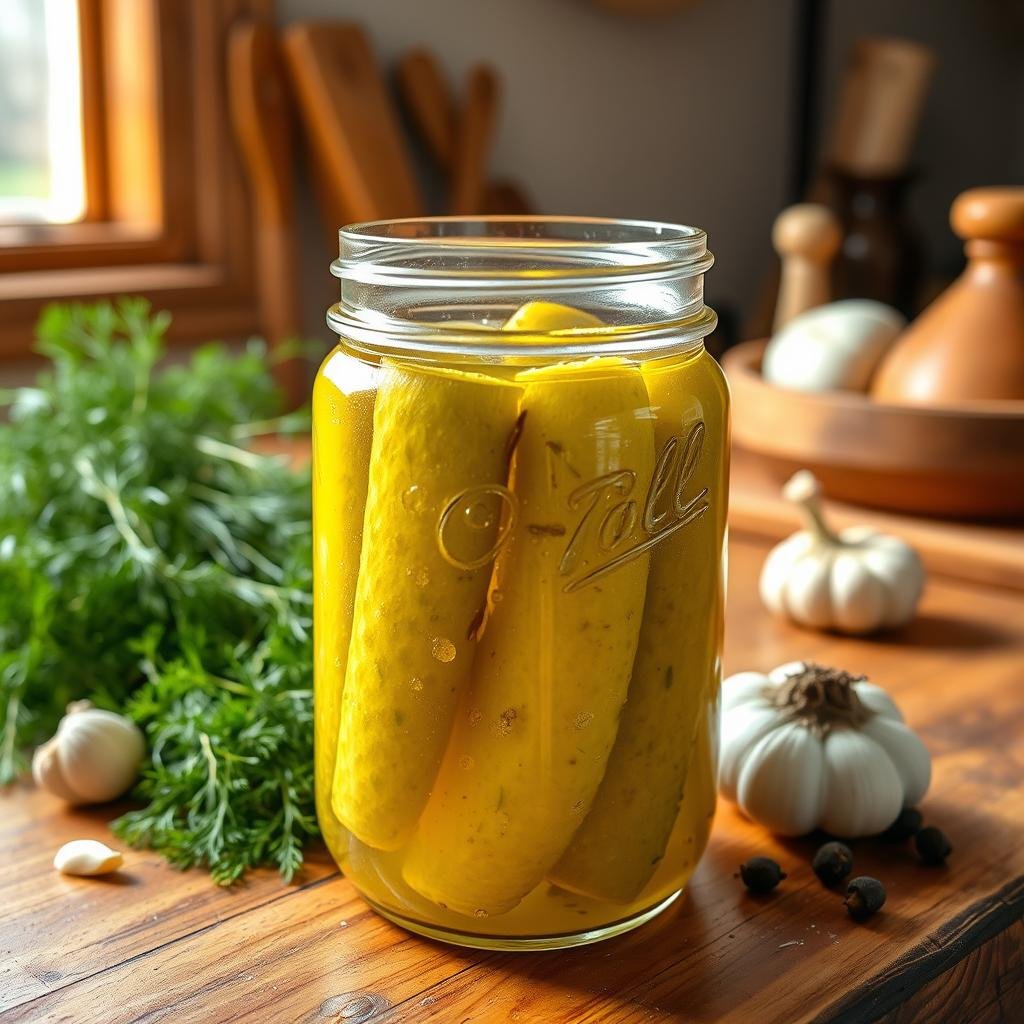
Learn how to make fermented dill pickles. They taste great and help your immune system. This recipe uses natural fermentation, a healthier way than modern methods.
Adding these pickles to your meals can make your immune system stronger. It also helps your gut health. Let’s see why fermented pickles are good for you.
Benefits of Fermented Dill Pickles for Immunity
Fermented dill pickles are known for their health perks, like boosting the immune system. This part will explore the benefits of these tangy treats. It will show how they help with overall health and wellbeing.
The Role of Probiotics
Probiotics in fermented dill pickles are good for you. They help keep your gut healthy, which is vital for a strong immune system. Eating fermented foods like pickles adds good bacteria to your body. This helps with digestion and absorbing nutrients, which boosts immunity.
Gut Health and Immunity
A healthy gut is linked to a strong immune system. Fermented dill pickles help keep your gut healthy. They grow good bacteria and stop bad ones. This keeps your body’s defenses strong.
| Benefits | Details |
|---|---|
| Immune System Boost | Enhances the body’s natural defenses through improved gut health |
| Probiotic Benefits | Provides live cultures that promote a healthy microbiome |
| Gut Health | Supports digestion and nutrient absorption, vital for immunity |
| Fermented Dill Pickle Benefits | Improves overall health by balancing gut bacteria |
Ingredients for Brined Dill Pickle Recipe
Making the perfect brined dill pickle starts with picking the right ingredients. High-quality items give the best flavor and help with fermentation. This makes the pickles healthy and tasty. Let’s look at what you need for the best results.
Choosing the Best Pickling Cucumbers
Look for small, firm cucumbers without blemishes. Kirby or Persian cucumbers are great because they’re crisp and absorb brine well. They keep their crunch and flavor during fermentation.
Essential Spices and Herbs
Pickling spices are key to great flavor in your brined dill pickles. A good mix includes mustard seeds, coriander seeds, peppercorns, and bay leaves. Fresh dill adds a real taste and smell, making the pickles even better.
The Importance of Quality Salt
Quality salt is important for fermentation. It helps good bacteria grow. Use non-iodized kosher salt or sea salt without additives. This ensures your pickles taste right and stay fresh.
| Key Ingredients | Benefits |
|---|---|
| Pickling Cucumbers | Crisp texture, absorb brine well |
| Pickling Spices | Flavor enhancement, preservation |
| Fresh Dill | Aroma, authentic taste |
| Quality Salt | Optimal fermentation, flavor balance |
Step-by-step Guide to Making Brined Dill Pickles
Making delicious dill pickles at home is fun. This guide will show you how to make perfect pickles.
Preparing Your Cucumbers
Start by picking firm, fresh cucumbers. Rinse them well to get rid of dirt. Cutting off the blossom end helps prevent mushiness.
Creating the Perfect Brine
Making the brine is key. Mix water, salt, and flavorings like garlic and dill. Use about 5% salt for good fermentation. Make sure the brine covers all cucumbers.
Assembling Your Ingredients
Now, get your cucumbers and brine ready. Put garlic, dill, and spices at the jar’s bottom. Add cucumbers, leaving some space. Pour brine over them and add a weight to keep them down.
Fermentation Process Explained
Knowing how fermentation works is important. Close the jar and keep it at room temperature. Soon, you’ll see bubbles and cloudy brine. After 7 days, taste them. If they’re good, put them in the fridge to keep them crunchy.
Tips for Achieving Crunchy Pickles
Making homemade pickles crunchy is key. Here are tips for the right temperature and using natural tannic acid sources.
Temperature Control
Keeping the right temperature for fermentation is important. Aim for 65°F to 75°F. Temperatures outside this range can make pickles mushy.
Watch the temperature closely and adjust as needed. If it’s too warm, use a cooler or a temperature-controlled chamber.
Using Tannic Acid Sources
Adding natural tannic acid sources to your jar helps. Tannins make vegetables firmer. Grape leaves, bay leaves, oak leaves, or black tea are good choices.
These add tannic acid without chemicals. Follow these tips for crunchy pickles every time.
How Long to Ferment Your Pickles
Finding the right time to ferment your pickles depends on taste and environment. The time can vary from days to weeks. It depends on whether you want a half-sour or full-sour pickle.
In the first 3-5 days, you’ll see bubbles and a cloudy brine. This means fermentation is happening. People who like their pickles light and crisp prefer this stage. Half-sour pickles usually ferment for 4 to 6 days.
For a tangier pickle, ferment for 2 to 4 weeks. Temperature affects fermentation. Warmer places speed it up, cooler ones slow it down. Salt levels also play a part, with more salt slowing it down.
Knowing the fermentation stages helps with taste and texture. Check your pickles often and taste them. This way, you get the perfect pickle flavor and crunch for you.
Storage and Shelf Life of Fermented Dill Pickles
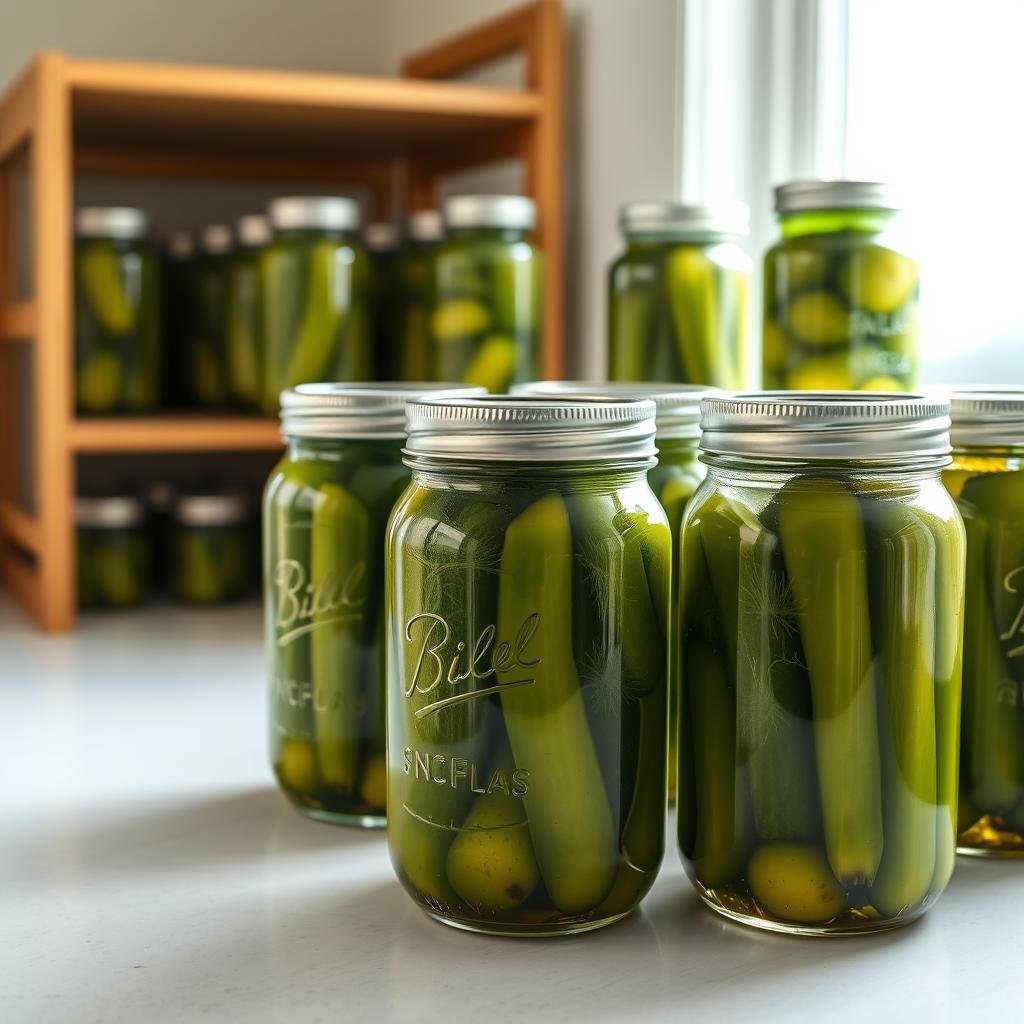
Storing pickles right can make them last longer and taste better. Start by sealing the containers well. Move the pickles to the fridge once they’re fermented to keep them fresh.
The acidity and salt in pickles help keep them good for a long time. More salt means more flavor and better preservation. Always watch for signs of bad pickles, like a weird smell or mold. Here’s what you need to know about storing pickles:
| Storage Method | Optimal Temperature | Expected Shelf Life |
|---|---|---|
| Room Temperature | 68-72°F (20-22°C) | 1-2 Weeks |
| Refrigeration | 34-38°F (1-3°C) | 6-12 Months |
| Freezing | 0°F (-18°C) | 12-18 Months |
To keep pickles fresh, use clean tools when you touch them. Following these tips will help your fermented dill pickles stay tasty and safe to eat for a long time.
Creative Uses for Brined Dill Pickles in Your Diet
Brined dill pickles are more than just a side dish. They can spice up your meals and snacks. They add flavor and health benefits to your diet.
Snack Ideas
Looking for new snack ideas? Try these: Wrap dill pickle spears in turkey or ham for a tasty snack. It’s full of protein and probiotics.
For a richer treat, make pickle chips with batter. They’re crispy and great with spicy aioli.
Another great idea is to make tangy popcorn seasoning with pickle brine. Mix dried dill and garlic powder with your popcorn for a unique flavor.
Learn more about using pickle brine in your cooking.
Incorporating into Meals
Using pickles in meals opens up a world of flavors. Use pickle slices instead of lettuce in sandwiches. Or add them on top of burgers for extra flavor.
Pickles are also great in salads. They add a refreshing touch to creamy dressings.
For a twist, cook with pickles by adding pickle juice to marinades. It tenderizes and adds flavor to meats and tofu. Also, add pickle brine to potato salad or deviled eggs for a special touch.
Explore more dill pickle recipes. Use pickle brine in sautéed veggies, hot chicken, or even bread. It brings a unique zest to your dishes.
Common Issues and Troubleshooting
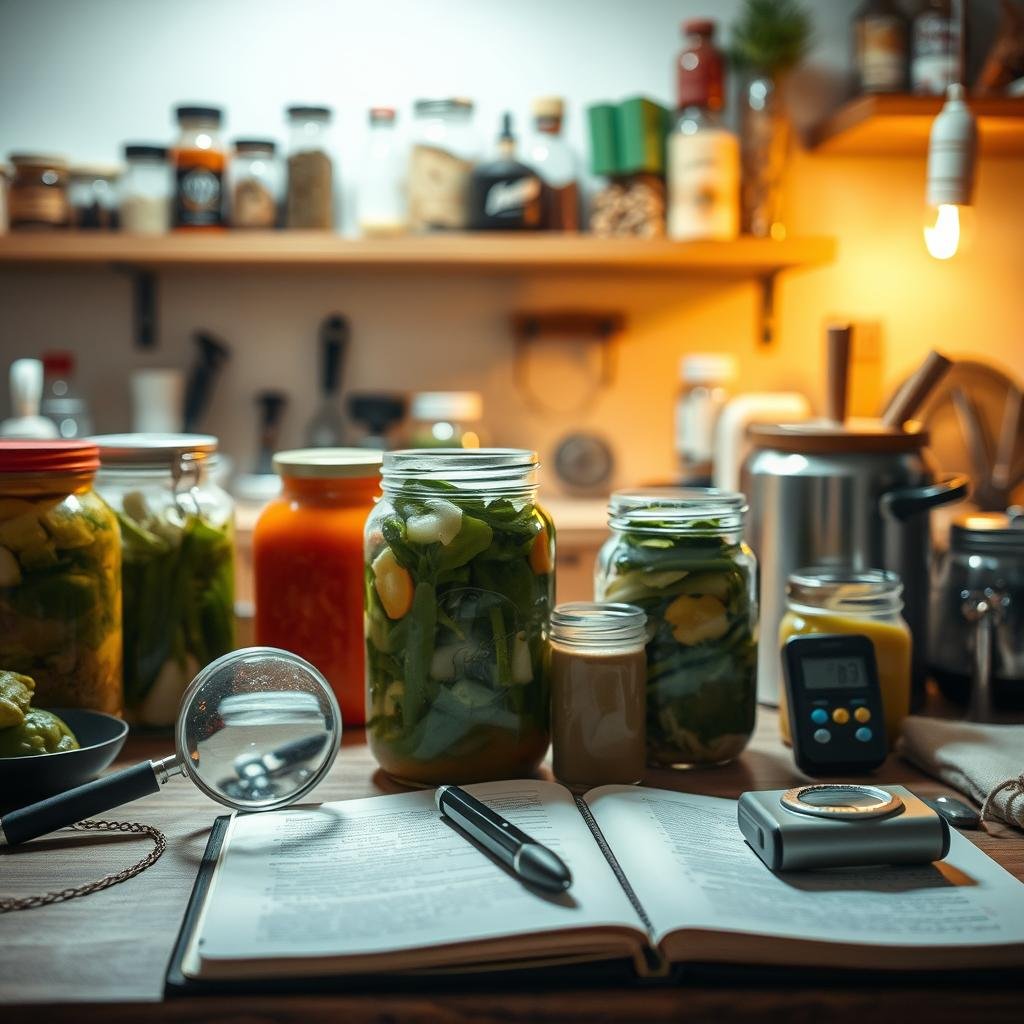
Fermenting pickles can be rewarding, but you might face problems. Knowing how to fix issues like mold and cloudy brine can help a lot. This knowledge can make your pickling journey more successful.
Preventing Mold
Mold is a big worry during fermentation. To stop mold, make sure cucumbers are fully in the brine. A fermentation weight can help keep them down.
Cleanliness is key—sterilize your jar and tools to avoid contamination. Also, keep the jar’s headspace right to fight mold.
Brine Cloudiness
Cloudy brine can mean different things, but it’s often part of fermentation. For clear brine, use good salt and distilled water. The right salt and water help keep it clear.
Check the brine often and remove any scum. This keeps it clear and nice.
| Issue | Solution |
|---|---|
| Mold Growth | Ensure full submersion, use sterilized equipment, maintain headspace |
| Cloudy Brine | Use non-iodized salt, distilled water, remove surface scum |
Brined Dill Pickle Recipe and Fermentation Safety Tips
Keeping dill pickle safety in mind means knowing safe fermentation practices. It’s key to be clean by using sanitized tools and containers. This helps avoid bad bacteria during fermentation.
Always check for signs of bad fermentation like bad smells or mold. This is important for health safety in pickling.
Using the right mix of ingredients is also vital. The salt-to-water ratio in your brine helps good bacteria grow. Aim for 2-3% salt by weight for the best results.
Also, make sure the cucumbers stay under the brine. This stops mold from growing. A simple way to do this is with a weight.
| Fermentation Element | Recommended Practice |
|---|---|
| Utensils and Containers | Sanitize thoroughly before use |
| Brine Ratio | Use a 2-3% salt concentration by weight |
| Submersion | Keep cucumbers fully submerged below brine |
| Monitoring | Check regularly for off odors and visible mold |
By sticking to these tips, you ensure dill pickle safety. This makes your pickling journey safe and fun. Always put health safety in pickling first.
Comparing Fermentation and Vinegar Pickling
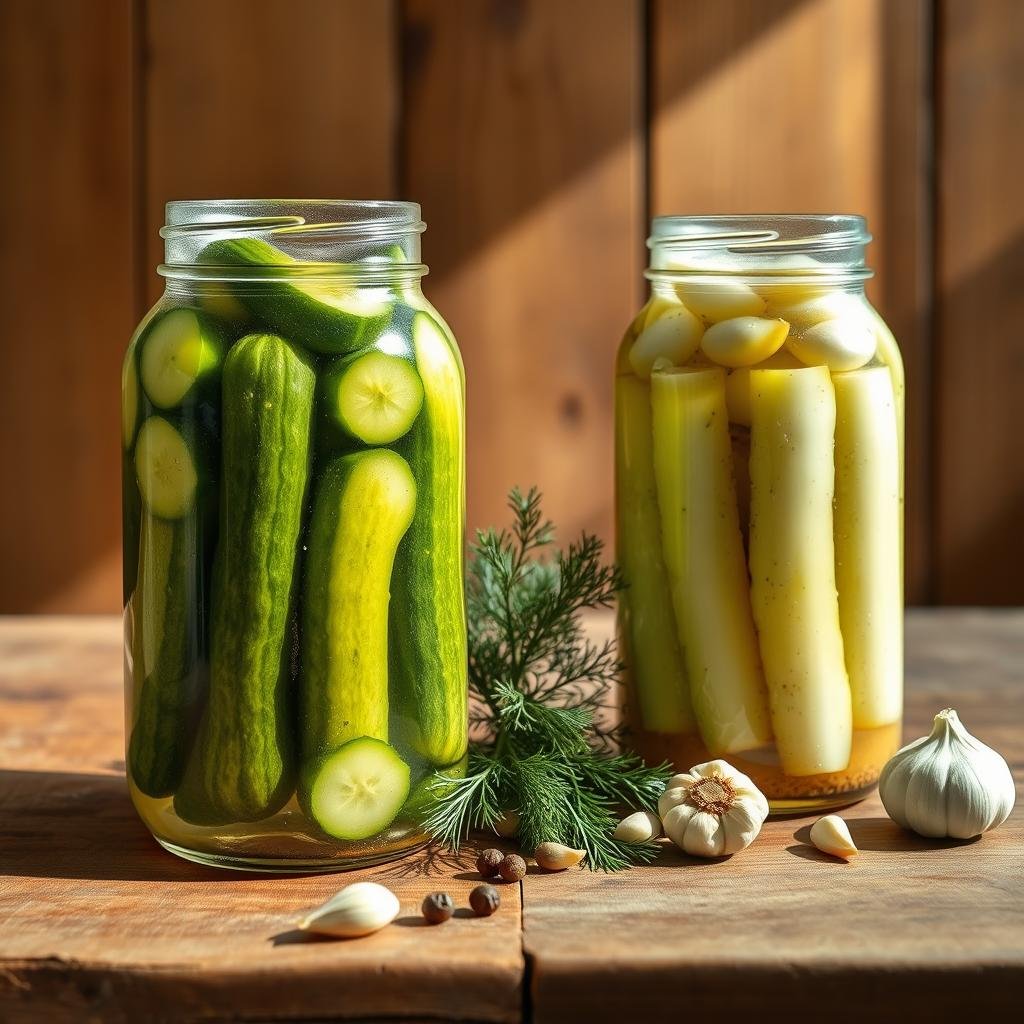
When we look at ways to keep food fresh, we often talk about fermentation vs. vinegar pickling. Fermentation is better for health, thanks to its many benefits.
Fermentation uses natural bacteria to turn vegetable sugars into lactic acid. This makes food taste better and adds good bacteria for our gut. These good bacteria help our immune system, showing why fermentation is great.
Vinegar pickling, on the other hand, uses acetic acid to keep food fresh. It’s faster and easier for newbies. But, it doesn’t have the health benefits of fermented foods. Yet, vinegar pickles can add a nice tang to dishes.
| Aspect | Fermentation | Vinegar Pickling |
|---|---|---|
| Preservation Method | Natural bacteria convert sugars into lactic acid | Vegetables soaked in vinegar solution |
| Health Benefits | Contains probiotics; boosts immunity | No probiotics; flavor enhancement |
| Flavor Profile | Complex, tangy, and slightly sour | Tangy and sharp |
| Ease of Preparation | Requires time and controlled environment | Quick and simple |
In summary, both methods have their uses in cooking. But, fermentation’s health benefits and tasty flavors make it a top choice for better health.
Why Homemade Dill Pickles are Healthier
Making dill pickles at home is healthier because you control the ingredients. Unlike store-bought ones, homemade pickles use natural methods and no additives. This makes them better for you, with more nutrients and less harm from preservatives.
Natural Ingredients
Homemade pickles use natural ingredients like fresh cucumbers and organic spices. They are made with quality salt, too. This approach is better for your health and taste buds.
For a gut-friendly option, try fermented dill pickles. They are made with salt, not vinegar. This makes them taste milder and packed with good bacteria (learn more here).
Absence of Additives
Homemade pickles don’t have additives. Store-bought ones might have preservatives and artificial colors. Homemade pickles keep their natural taste and are healthier for you.
Here’s a comparison of homemade and store-bought pickles:
| Criteria | Homemade Pickles | Store-bought Pickles |
|---|---|---|
| Ingredients | Natural, fresh, organic | May contain additives and preservatives |
| Flavor | Mild, complex umami from natural pickling | Often enhanced with artificial flavors |
| Health Benefits | Rich in probiotics, gut-healthy | Potential exposure to harmful chemicals |
The Science Behind Fermentation and Immunity Boost
The magic of fermentation comes from nature and science working together. It’s key to know how lactic acid bacteria make our foods better. This is why fermented dill pickles are so good for us.
Science shows us that fermentation does more than just keep food fresh. It also makes it more nutritious.
Lactic Acid Bacteria
Lactic acid bacteria are the heart of fermentation. They live in the absence of air and turn sugars into lactic acid. This makes pickles taste tangy and is good for our health.
These bacteria help our gut and boost our immune system. They keep our gut healthy and make our immune system stronger.
Bioavailability of Nutrients
Fermentation makes nutrients in food easier for our bodies to use. Lactic acid bacteria break down bad stuff in cucumbers. This lets our body get more of the good stuff.
This is great for vitamins and minerals that keep us healthy. Here’s how fermentation helps:
| Original Nutrient | After Fermentation | Impact |
|---|---|---|
| Phytic Acid | Reduced | Enhanced mineral absorption |
| B Vitamins | Increased | Boosted energy levels |
| Vitamin K2 | Produced | Improved bone health |
In short, fermentation makes dill pickles taste better and last longer. It also gives us big health benefits. Fermented dill pickles are full of good stuff that helps our immune system.
Making Fermented Pickles a Family-Friendly Activity
Doing family pickling activities is fun and educational for everyone. It includes preparing ingredients and watching the fermentation process. It’s a great way to bond and teach kids about food preservation and healthy eating.
Steps Kids Can Help With
Children can help with many parts of pickling, making it a fun educational cooking activity. Here are some tasks kids can do:
- Washing and drying pickling cucumbers.
- Peeling and smashing garlic cloves.
- Adding bay leaves, pickling spice, and fresh dill into mason jars.
- Mixing large granule sea salt with water to create the brine.
- Helping to label jars with the fermentation start date.
Educational Value
Educational cooking like making fermented pickles teaches important lessons. Kids learn about microbes and how they ferment food. They also learn about measuring and timing.
Teaching kids about these topics helps them understand food science and nutrition. It shows them the value of eating healthy.
Adding kids cooking activities to pickling projects sparks curiosity. It encourages a lifelong love for making healthy, homemade foods.
FAQs About Fermented Dill Pickles and Immunity
Fermented dill pickles are tasty and full of good bacteria for your gut. We’ll answer some common questions about making them. If you’re new, you might wonder about the best temperature for pickles. It’s between 60-70°F, which keeps them crunchy and helps good bacteria grow.
Many people ask how long pickles need to ferment. Half-sour pickles take 3-5 days, and full-sour ones need 14-21 days. Longer fermentation means more probiotics for your gut. For more tips and safety info, visit Feasting at Home.
People also ask about ingredients. You’ll need 2 lbs of cucumbers, 5 cups of water, and 2 tablespoons of sea salt. Adding garlic and dill makes them taste better and adds more nutrients. And yes, you can drink the brine! It’s full of probiotics and good for your gut and immune system.

